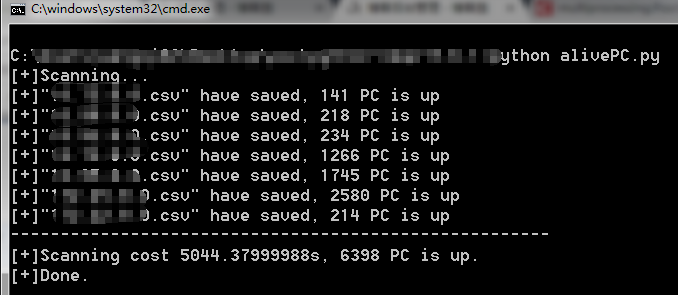python nmap模块使用进行主机探测(ICMP)
终于审核通过了......第一次用博客,想记录自己的学习情况,分享知识。
废话不多说,第一篇blog,大牛请轻喷。
资产清点首先需要进行主机探测,将存活主机统计下来再进行进一步的指纹识别及端口探测。若直接进行全网段IP扫描是很浪费时间的,不如先使用ICMP进行主机存活状态的探测后,再针对的进行扫描。(基于ping的方式有可能有误差,但是这里主要考虑的是效率)
python的第三方nmap模块的安装,网上有相关教程,不多赘述。
由于需要跟踪累计PC存活总数,使用了类方法。但同时遇到的问题就是:使用多进程后会出现以下报错信息:
cPickle.PicklingError: Can't pickle <type 'instancemethod'>: attribute lookup __builtin__.instancemethod failed
查了一下解决方法大概有三种:
- 用线程替换进程
- 可以使用copy_reg来规避上面的异常.
dill或pathos.multiprocesssing:use pathos.multiprocesssing, instead of multiprocessing. pathos.multiprocessing is a fork of multiprocessing that uses dill. dill can serialize almost anything in python, so you are able to send a lot more around in parallel.
这里使用第一种方法进行修改,直接上代码:
1 import nmap 2 from multiprocessing.pool import ThreadPool as Pool 3 import time 4 import csv 5 6 7 class Scan(object): 8 def __init__(self): 9 self.count = 0 10 11 def scan(self, ip): 12 csv_write =[] 13 nm = nmap.PortScanner() 14 nm.scan(hosts=ip, arguments='-n -sn -PE') 15 hosts_list = [(x, nm[x]['status']['state']) for x in nm.all_hosts()] 16 for host, status in hosts_list: 17 # print '{0}:{1}'.format(host, status) 18 csv_write.append([host, status]) 19 name = ip.split('/')[0] + '.csv' 20 # print name 21 with open(name, 'wb') as csvfile: 22 fieldnames = ['ip', 'status'] 23 w = csv.writer(csvfile, dialect='excel') 24 w.writerow(fieldnames) 25 w.writerows(csv_write) 26 print '[+]\"%s\" have saved, %d PC is up' % (name, len(hosts_list)) 27 self.count += len(hosts_list) 28 29 def get_ips(self, file): 30 ipList = [] 31 with open(file) as f: 32 for line in f.readlines(): 33 ipList.append(line.strip()) 34 return ipList 35 36 def run(self): 37 startTime = time.time() 38 print '[+]Scanning...' 39 ip_txt = 'C:\zichan.txt' 40 ipList = self.get_ips(ip_txt) 41 # print ipList 42 pool = Pool(5) 43 resultList = pool.map(self.scan, ipList) 44 pool.close() 45 pool.join() 46 endTime = time.time() 47 print '------------------------------------------------------' 48 print '[+]Scanning cost %ss, %d PC is up.' % (endTime - startTime, self.count) 49 print '[+]Done.' 50 51 if __name__ == '__main__': 52 myScan = Scan() 53 myScan.run()
比较简单的方法实现,实际情况下扫描7个内网B段大概不到一个半小时,讲道理比直接使用nmap快很多(对比的nmap现在还没有跑完,嗯)
保存格式为CSV文件,控制台输出如下:

后面会尝试优化,并添加新的功能如端口扫描、系统指纹、漏洞探测等,这次就这样!水平有限,嘻嘻。



